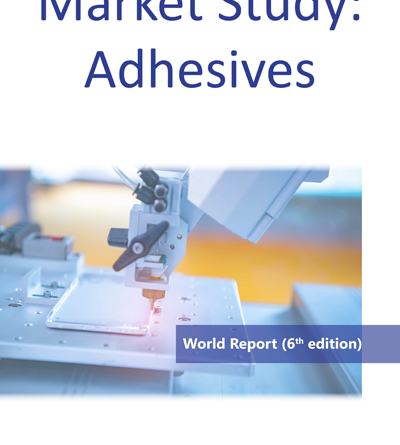Ceresana release new study on the global market for adhesives
Konstanz, Germany – Adhesives are tailor-made for a broad range of applications: There are already more than 250,000 different adhesive formulations, and the number is steadily increasing. These mostly invisible helpers not only provide adhesion and bonding, they also offer thermal and sound insulation, protection against moisture, electrical conductivity, pest control and other innovative functions. Ceresana has analyzed the global market for adhesives for the sixth time: Around 13.5 million tons of adhesives are currently consumed every year. The current edition of the adhesives market study provides key information on demand, production, imports and exports from 2020 onwards – and forecasts up to 2032.
With a share of around 38.2% of global adhesives sales, Asia-Pacific is the largest adhesives market, followed by North America and Western Europe. In Europe, the “paper and packaging” segment uses the most adhesives. However, the construction industry is the most important sales market worldwide: Around 27.5% of global adhesive consumption is accounted for by wall and floor coverings, the repair and renovation of buildings, components such as cladding and panels and even insulation materials. In the automotive industry, lightweight car bodies and batteries for electromobility are further increasing the demand for adhesives; thermoset composite materials for wind turbine rotor blades are also bonded. However, adhesive consumption is currently growing most strongly in the “shoes, leather and textiles” application area. Even very old forging technology has competition: Hoof protection for horses is increasingly attached with superglue.
Biobased adhesives, which are at least partially made from renewable raw materials, are developing dynamically – and not just in special applications such as bottle labels or wallpaper paste. However, conventional petrochemical plastic products still have the largest market share. Vinyl adhesives represent the most important product type with a current annual demand of around 3.95 million tons. There is a wide variety of vinyl-based adhesives. Products based on polyvinyl acetate (PVAC) are among the most important ones. Polyvinyl alcohol (PVA), manufactured from polyvinyl acetate, is used as an adhesive for porous materials, such as paper, cardboard, wood, cork, and leather. Vinyl products are followed by acrylic-based adhesives, polyurethane, elastomers, epoxy and other adhesives. Polyurethane adhesives and reactive adhesives are currently experiencing the strongest growth. Water-based adhesives account for around 46% of total consumption. Hot-melt adhesives follow well behind.

